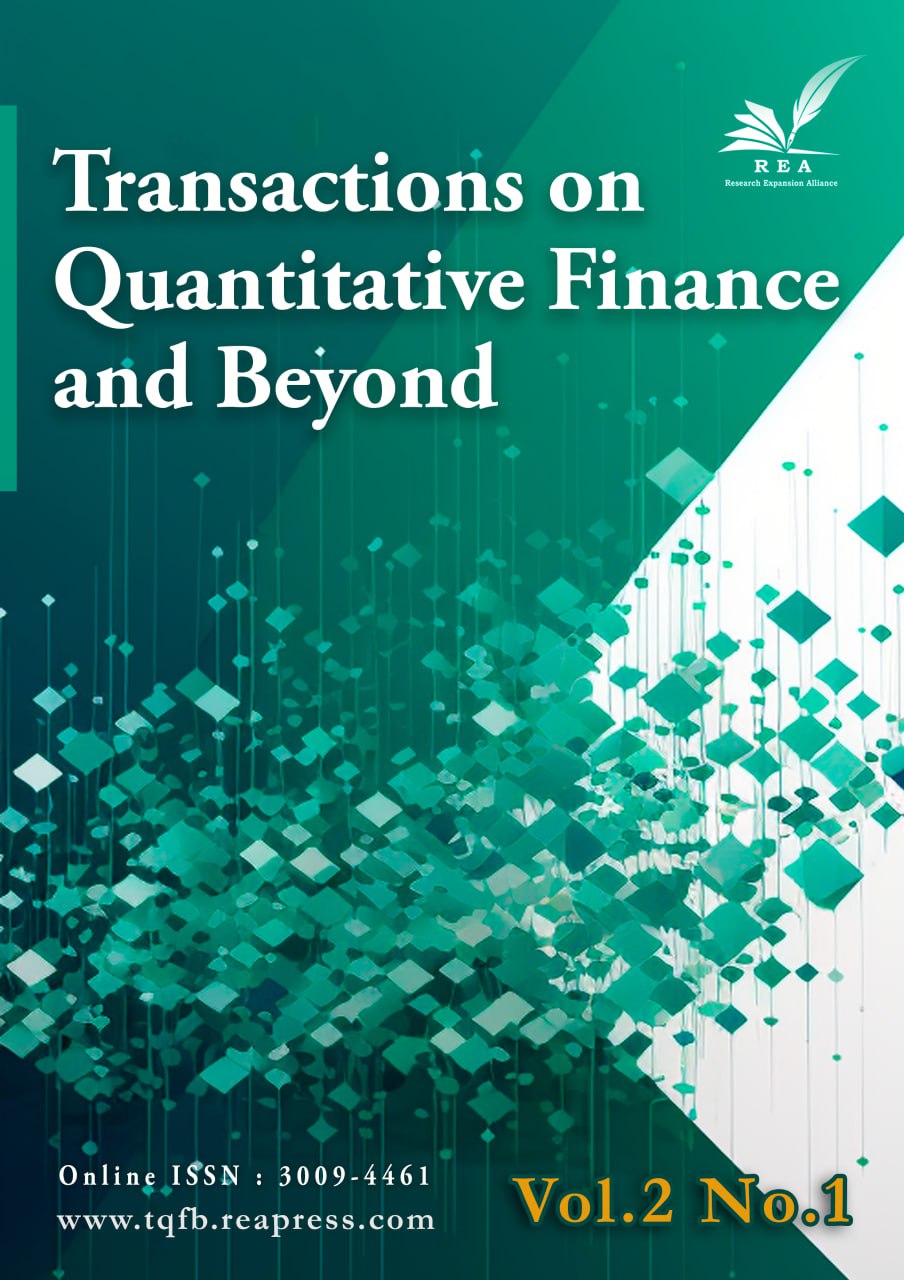Economic Policy Uncertainty, Credit Risk, and Lending Decisions: Banks Listed on the Tehran Stock Exchange
Abstract
This research investigates the relationship between Economic Policy Uncertainty (EPU), credit risk, and lending decisions using the Generalized Method of Moments (GMMs) over the period from 2019 to 2023 for 12 banks listed on the Tehran Stock Exchange. The study employs three regression models to analyze the dynamics of Non-Performing Loans (NPLs), Loan-To-Deposit Ratios (LTDRs), and Return on Assets (ROAs) within the banking sector. Findings reveal a significant persistence in NPLs, indicating that banks with higher past NPLs face ongoing challenges that adversely affect their financial health. A notable negative relationship between Leverage (Lev) and Non-Performing Loan Ratio (NPLR) suggests that more leveraged banks may implement effective risk management strategies, reducing their exposure to NPLs. Additionally, capital adequacy emerges as a critical factor, with higher capital ratios correlating with lower NPLs. The analysis of LTDR indicates that Lev and capital adequacy significantly influence lending practices, while a marginally significant relationship between EPU and LTDR suggests external uncertainties may slightly impact lending decisions. Model results further demonstrate strong persistence in profitability, with historical ROA positively predicting current ROA. Overall, this study underscores the importance of effective risk management practices in banking and highlights ongoing challenges posed by NPLs, particularly for larger institutions. Recommendations include prioritizing capital buffers and monitoring lending practices to mitigate risks while fostering sustainable profitability growth. Future research should explore additional variables to elucidate the complexities of banking performance metrics.
Keywords:
Economic policy uncertainty, Credit risk, Lending decisions, PerformanceReferences
- [1] Baker, S. R., Bloom, N., & Davis, S. J. (2016). Measuring economic policy uncertainty. The quarterly journal of economics, 131(4), 1593–1636. https://doi.org/10.1093/qje/qjw024
- [2] Baker, S. R., Davis, S. J., & Levy, J. A. (2022). State-level economic policy uncertainty. Journal of monetary economics, 132, 81–99. https://doi.org/10.1016/j.jmoneco.2022.08.004
- [3] Glantz, M. (2003). Managing bank risk: An introduction to broad-base credit engineering. Academic press. https://B2n.ir/h89951
- [4] Trinh, N. T., & Vu, T. Q. (2024). The impact of economic policy uncertainty on bank stability and the moderating effect of ownership structure: empirical evidence from chinese listed commercial banks. International journal of information, business and management, 16(4), 109–137. https://B2n.ir/s53690
- [5] Ozili, P. K., & Arun, T. G. (2022). Does economic policy uncertainty affect bank profitability? International journal of managerial finance, 19(4), 803–830. https://doi.org/10.1108/IJMF-04-2022-0177
- [6] Hall, S. (2001). Credit channel effects in the monetary transmission mechanism. Bank of england quarterly bulletin, winter. https://ssrn.com/abstract=762308
- [7] Saha, S., Sen, K., & Chandra Bishwas, P. (2024). Nexus between economic policy uncertainty and bank liquidity creation: moderating role of bank regulations and credit risk. Finance & economics review, 6(1), 45–60. https://doi.org/10.38157/fer.v6i1.621
- [8] Jing, Z., Lu, S., Zhao, Y., & Zhou, J. (2023). Economic policy uncertainty, corporate investment decisions and stock price crash risk: evidence from China. Accounting & finance, 63(S1), 1477–1502. https://doi.org/10.1111/acfi.13077
- [9] Huynh, J. (2024). Financial investment under banking uncertainty: evidence from Vietnamese firms. Post-communist economies, 36(8), 930–958. https://doi.org/10.1080/14631377.2024.2437621
- [10] Calmès, C., & Théoret, R. (2014). Bank systemic risk and macroeconomic shocks: Canadian and U.S. evidence. Journal of banking & finance, 40, 388–402. https://doi.org/10.1016/j.jbankfin.2013.11.039
- [11] Talavera, O., Tsapin, A., & Zholud, O. (2012). Macroeconomic uncertainty and bank lending: the case of Ukraine. Economic systems, 36(2), 279–293. https://doi.org/10.1016/j.ecosys.2011.06.005
- [12] Bernanke, B. S. (1983). Irreversibility, uncertainty, and cyclical investment. The quarterly journal of economics, 98(1), 85–106. https://doi.org/10.2307/1885568
- [13] Çolak, M. S., & Şenol, A. (2021). Bank ownership and lending dynamics: evidence from Turkish banking sector. International review of economics & finance, 72, 583–605. https://doi.org/10.1016/j.iref.2020.11.014
- [14] Orden-Cruz, C., Paule-Vianez, J., & Lobão, J. (2023). The effect of economic policy uncertainty on the credit risk of US commercial banks. International journal of finance & economics, 28(3), 3420–3436. https://doi.org/10.1002/ijfe.2600
- [15] Ozili, P. K. (2021). Economic policy uncertainty in banking: A literature review. In handbook of research on financial management during economic downturn and recovery (pp. 275-290). IGI Global. https://doi.org/10.4018/978-1-7998-6643-5.ch015
- [16] Zabavnik, D., & Verbič, M. (2024). Unravelling the credit market shocks and investment dynamics: A theoretical and empirical perspective. International review of financial analysis, 94, 103283. https://doi.org/10.1016/j.irfa.2024.103283
- [17] Su, X., Zhou, S., Xue, R., & Tian, J. (2020). Does economic policy uncertainty raise corporate precautionary cash holdings? evidence from China. Accounting & finance, 60(5), 4567–4592. https://doi.org/10.1111/acfi.12674
- [18] Li, S., & Hu, S. (2024). Capital regulation reforms and bank risk-taking in China. Emerging markets finance and trade, 60(12), 2827–2849. https://doi.org/10.1080/1540496X.2024.2330455
- [19] Chi, Q., & Li, W. (2017). Economic policy uncertainty, credit risks and banks’ lending decisions: evidence from Chinese commercial banks. China journal of accounting research, 10(1), 33–50. https://doi.org/10.1016/j.cjar.2016.12.001
- [20] Wang, C., & Duan, R. (2025). Impact of economic policy uncertainty on bank loan restructuring: empirical evidence from industry-level loan distribution in China. Sage open, 15(1), 21582440241310310. https://doi.org/10.1177/21582440241310313
Downloads
Published
Issue
Section
License
Copyright (c) 2025 Transactions on Quantitative Finance and Beyond

This work is licensed under a Creative Commons Attribution 4.0 International License.







